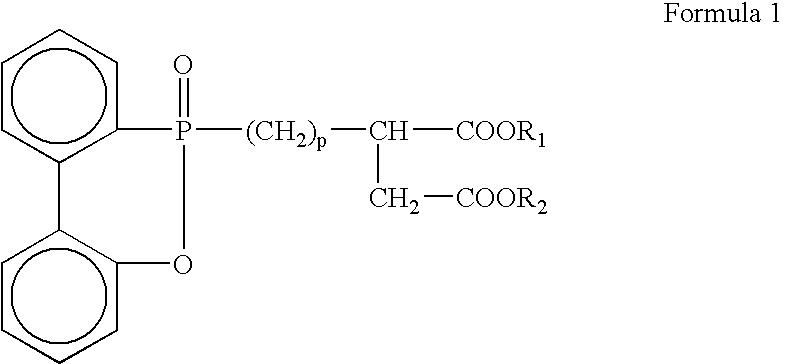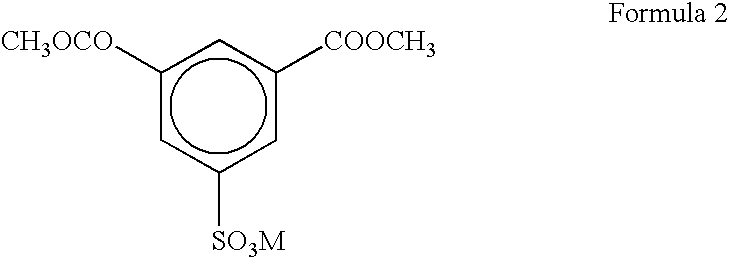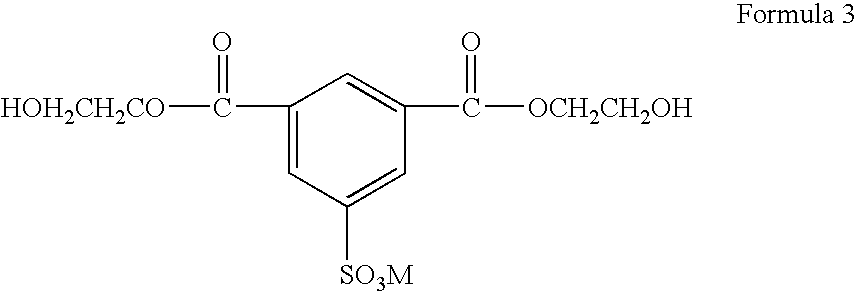Flame-retardant polyester polymer dyeable with cationic dye, method of producing the same, and copolyester fiber using the same
- Summary
- Abstract
- Description
- Claims
- Application Information
AI Technical Summary
Benefits of technology
Problems solved by technology
Method used
Image
Examples
example 1
[0050] After DMS, in which M was Na, was dissolved in EG in a reactor provided with a methanol discharging unit so that a content of DMS was 60%, 5 wt % of sodium hydroxide (NaOH) was added as a catalyst for an ester interchange reaction to the resulting solution based on DMS, thereby initiating a reaction. When the content of discharged methanol exceeded 99% of a theoretical value, heating was stopped and the reactor was cooled to produce DES.
[0051] Slurry was prepared using DES so that a molar ratio of DES / (TPA+DES) was 1.5, and in this case, a molar ratio of EG to all acid components (TPA+DES) was 1.15.
[0052] Base oligomers having the same composition as the slurry were agitated at 255° C. in an esterification bath, and the slurry was fed into the esterification bath while an inside temperature of the reactor was maintained at 255° C. After the completion of feeding of the slurry, the agitation was continued for 30 min, when an extent of the esterification was 95%, the resultin...
example 2
[0055] After DMS, in which M was Na, was dissolved in EG in a reactor provided with a methanol discharging unit so that a content of DMS was 60%, 5 wt % of sodium hydroxide (NaOH) was added as a catalyst for an ester interchange reaction to the resulting solution based on DMS, thereby initiating a reaction. When the content of discharged methanol exceeded 99% of a theoretical value, heating was stopped and the reactor was cooled to produce DES.
[0056] Slurry was prepared using DES so that a molar ratio of DES / (TPA+DES) was 1.2, and in this case, a molar ratio of EG to all acid components (TPA+DES) was 1.15.
[0057] Base oligomers having the same composition as the slurry were agitated at 255° C. in an esterification bath, and the slurry was fed into the esterification bath while an inside temperature of the reactor was maintained at 255° C. After the completion of feeding of the slurry, the agitation was continued for 30 min, when an extent of the esterification was 95%, the resultin...
example 3
[0060] Slurry was prepared so that a molar ratio of EG / TPA was 1.15.
[0061] A molar ratio of DES / (TPA+DES) was maintained at 1.5, a DE reaction bath was maintained at 255° C. with the agitation, and the agitation was continued for 30 min after the slurry and DES were sequentially fed into the DE reaction bath. The feeding of the slurry and DES was conducted in such a way that their amounts were controlled so that the molar ratio of DES / (TPA+DES) was 1.5, and the reaction was then continued for 30 min, thereby an extent of the reaction approached 95.2%.
[0062] The, resulting product was moved to a polycondensation bath, a flame retardant, including hydroxy ethyl groups (CH2CH2OH) as R1 and R2 in Formula 1, was fed into the polycondensation bath so that the content of a phosphorus atom contained in the flame retardant was 6100 ppm, manganese acetate was fed as a manganese salt into the polycondensation bath so that the content of a manganese atom was 55 ppm, phosphoric acid was fed as...
PUM
| Property | Measurement | Unit |
|---|---|---|
| Fraction | aaaaa | aaaaa |
| Fraction | aaaaa | aaaaa |
| Fraction | aaaaa | aaaaa |
Abstract
Description
Claims
Application Information
 Login to View More
Login to View More - R&D
- Intellectual Property
- Life Sciences
- Materials
- Tech Scout
- Unparalleled Data Quality
- Higher Quality Content
- 60% Fewer Hallucinations
Browse by: Latest US Patents, China's latest patents, Technical Efficacy Thesaurus, Application Domain, Technology Topic, Popular Technical Reports.
© 2025 PatSnap. All rights reserved.Legal|Privacy policy|Modern Slavery Act Transparency Statement|Sitemap|About US| Contact US: help@patsnap.com



